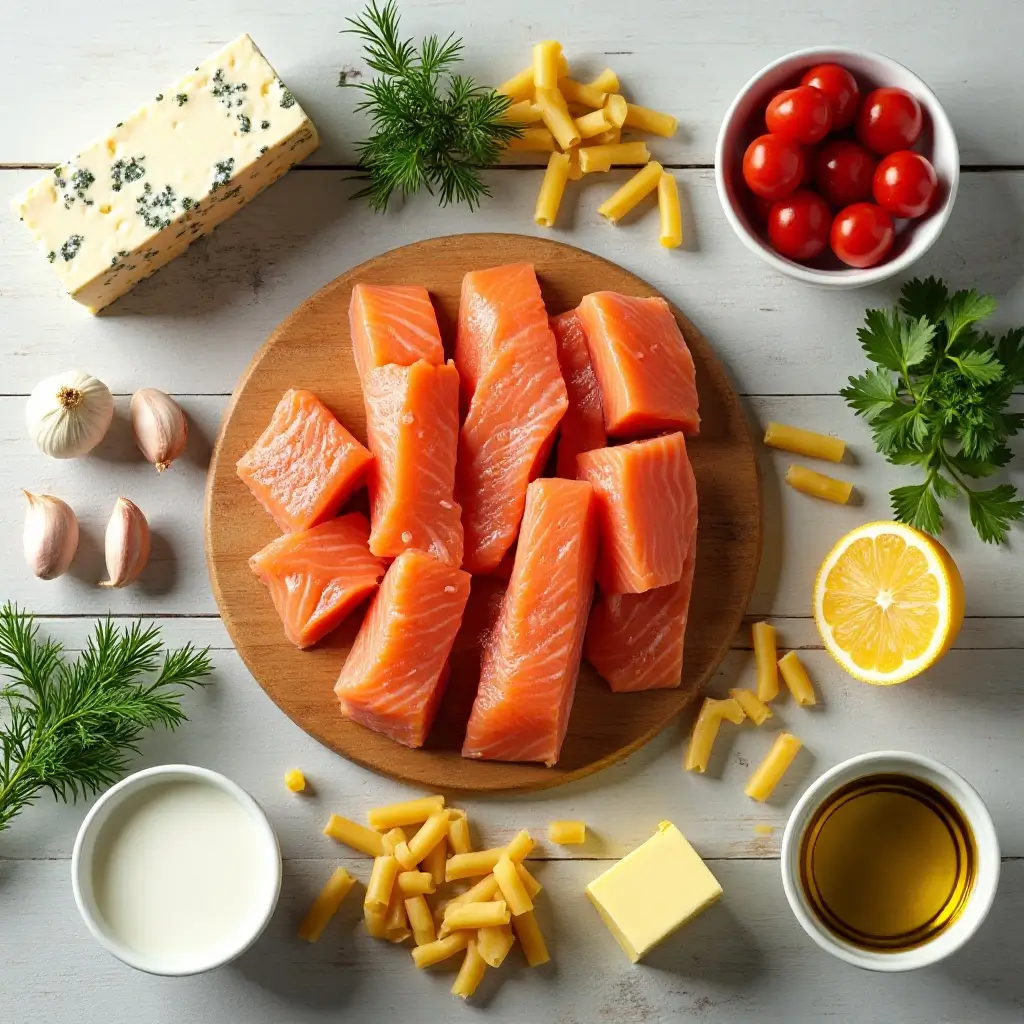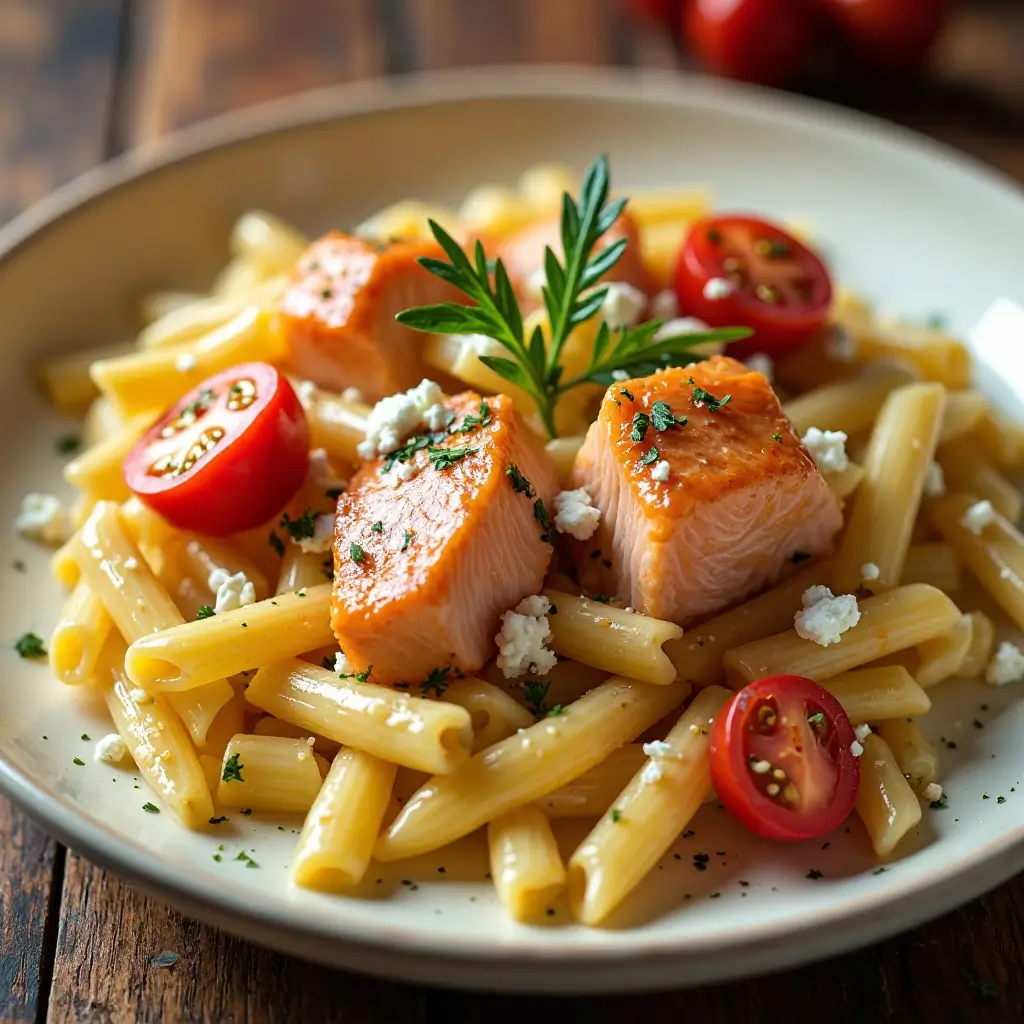One Pan Salmon Feta Pasta Ready in 20 Minutes
Picture this: tender flakes of salmon swimming in a luscious cream sauce, tangy feta cheese melting into every bite, and perfectly cooked pasta bringing it all together. This salmon feta pasta is pure comfort food magic that transforms simple ingredients into restaurant-quality elegance.
Just like our popular garlic butter shrimp pasta, this dish proves that impressive meals don’t require hours in the kitchen – just 20 minutes and a handful of quality ingredients for a dinner that’ll have everyone asking for seconds!
Table of Contents
What is Salmon Feta Pasta?
Ever wondered why we call it salmon feta pasta? Well, it’s pretty straightforward – this dish celebrates the beautiful marriage between flaky salmon and creamy feta cheese! But here’s the fun part: some food historians believe this combination was inspired by Greek fishermen who would toss their daily catch with local cheese and pasta.
As they say, “the way to a man’s heart is through his stomach,” and this recipe definitely proves that point. Ready to fall in love with your new favorite dinner?
Why You’ll Love This Salmon Feta Pasta:
Restaurant-Quality Flavor at Home
This salmon feta pasta delivers the kind of sophisticated taste you’d expect from an upscale restaurant, but you can make it in your own kitchen. The combination of buttery salmon, tangy feta, and aromatic herbs creates layers of flavor that dance on your taste buds. Each forkful offers the perfect balance of protein, creaminess, and Mediterranean-inspired goodness.
Budget-Friendly Gourmet Dining
Making this dish at home saves you serious money compared to ordering similar pasta dishes at restaurants. A single serving at a restaurant could cost $25-30, but you can make this entire recipe for a family of four for under $20. Plus, you control the quality of ingredients and can use wild-caught salmon for an even more premium experience.
Flavor-Packed Ingredients That Shine
The magic happens when cherry tomatoes burst in the pan, releasing their sweet juices. Fresh herbs like dill and parsley brighten every bite, while garlic and lemon zest add aromatic depth. Similar to our Mediterranean chicken pasta, this recipe proves that simple, quality ingredients create the most memorable meals. Why not give this a try tonight and discover your new favorite weeknight dinner?
How to Make Salmon Feta Pasta:
Quick Overview
This salmon feta pasta is incredibly easy to make and delivers maximum flavor with minimal effort. The creamy, herb-infused sauce perfectly complements the tender salmon and tangy feta cheese. What makes this dish special is its rich, velvety texture and the way the flavors meld together beautifully.
Total Time: 20 minutes
- Prep Time: 5 minutes
- Cook Time: 15 minutes
- Servings: 4 people
Key Ingredients for Salmon Feta Pasta:
Pasta & Protein:
- 12 oz penne or fusilli pasta
- 1 lb salmon fillet, skin removed, cut into bite-sized pieces
- 6 oz feta cheese, crumbled
Vegetables & Aromatics:
- 1 pint cherry tomatoes, halved
- 3 cloves garlic, minced
- 1 medium onion, diced
- 1 lemon (zested and juiced)
Sauce & Seasonings:
- 1 cup heavy cream
- 3 tablespoons olive oil
- 2 tablespoons butter
- 1/4 cup fresh dill, chopped
- 2 tablespoons fresh parsley, chopped
- Salt and black pepper to taste
- 1/2 teaspoon red pepper flakes (optional)

Step-by-Step Instructions:
Step 1: Prepare the Pasta
Bring a large pot of salted water to boil. Add pasta and cook according to package directions until al dente. Reserve 1 cup of pasta water before draining. Set pasta aside.
Step 2: Season and Sear the Salmon
Pat salmon pieces dry with paper towels. Season both sides with salt and pepper. Heat 2 tablespoons olive oil in a large skillet over medium-high heat. Add salmon pieces and cook for 3-4 minutes per side until golden and cooked through. Remove salmon to a plate and set aside.
Step 3: Build the Flavor Base
In the same skillet, add remaining olive oil and butter. Sauté diced onion for 3-4 minutes until softened. Add minced garlic and cook for another 30 seconds until fragrant.
Step 4: Create the Sauce
Add cherry tomatoes to the skillet and cook for 2-3 minutes until they start to soften and release juices. Pour in heavy cream and bring to a gentle simmer. Let it cook for 2-3 minutes to thicken slightly.
Step 5: Combine Everything
Add the cooked pasta to the skillet and toss to coat with the cream sauce. If the sauce seems too thick, add some reserved pasta water gradually. Gently fold in the cooked salmon pieces and crumbled feta cheese.
Step 6: Finish and Serve
Remove from heat and stir in fresh dill, parsley, lemon zest, and lemon juice. Season with salt, pepper, and red pepper flakes if using. Serve immediately while hot.
What to Serve Salmon Feta Pasta With:
Fresh Salads: A crisp arugula salad with lemon vinaigrette cuts through the richness perfectly. Try a classic Greek salad with cucumbers, olives, and tomatoes to complement the Mediterranean flavors.
Crusty Bread: Warm garlic bread or focaccia is perfect for soaking up any extra cream sauce. A simple baguette with herb butter also works beautifully.
Light Vegetables: Roasted asparagus, steamed broccoli, or sautéed spinach add color and nutrition without competing with the main dish.
Wine Pairings: A crisp Sauvignon Blanc or Pinot Grigio complements the salmon beautifully. For red wine lovers, a light Pinot Noir works wonderfully.

Top Tips for Perfecting Salmon Feta Pasta:
Choosing the Right Salmon
Use fresh, high-quality salmon fillets for the best flavor. Wild-caught salmon has a firmer texture and richer taste than farm-raised. If using frozen salmon, thaw it completely and pat very dry before cooking.
Don’t Overcook the Salmon
Salmon cooks quickly and continues cooking even after removing from heat. Look for an internal temperature of 145°F, but remember it will finish cooking when added back to the hot pasta.
Pasta Water is Your Friend
Save that starchy pasta water! It helps bind the sauce to the pasta and creates a silky texture. Add it gradually – you can always add more, but you can’t take it away.
Feta Cheese Tips
Use block feta and crumble it yourself for the best texture. Pre-crumbled feta often contains anti-caking agents that prevent smooth melting. Add feta at the end to prevent it from completely breaking down.
Fresh Herbs Make a Difference
Fresh dill and parsley are essential for authentic Mediterranean flavor. Add them at the very end to preserve their bright, fresh taste and vibrant color.
Storing and Reheating Tips:
Refrigerator Storage: Store leftover salmon feta pasta in an airtight container in the refrigerator for up to 3 days. The cream sauce may separate slightly, but this is normal.
Reheating Instructions: Reheat gently in a skillet over low heat, adding a splash of milk or cream to restore the sauce’s consistency. You can also reheat in the microwave at 50% power, stirring every 30 seconds.
Freezing Guidelines: While this dish is best enjoyed fresh, you can freeze it for up to 2 months. The texture may change slightly due to the cream sauce. Thaw overnight in the refrigerator before reheating.
Make-Ahead Tips: You can prep ingredients in advance, but it’s best to cook this dish fresh. Pre-cut the salmon and vegetables, and have everything ready for quick assembly.
Nutritional Information
| Nutrient | Per Serving |
|---|---|
| Calories | 580 |
| Protein | 35g |
| Carbohydrates | 48g |
| Fat | 28g |
| Fiber | 3g |
| Sodium | 820mg |
| Omega-3 | 1.2g |
Frequently Asked Questions
Can I use a different type of pasta?
Absolutely! While penne and fusilli work best because their shapes hold the creamy sauce well, you can use rigatoni, farfalle, or even linguine. Just adjust cooking time according to package directions.
What if I can’t find fresh dill?
Fresh dill gives the best flavor, but you can substitute with 1 tablespoon dried dill or use fresh basil for a different but equally delicious twist. Avoid dried parsley as it lacks flavor.
Can I make this dish dairy-free?
Yes! Replace heavy cream with full-fat coconut milk and use dairy-free feta cheese or nutritional yeast. The texture will be slightly different but still delicious.
How do I know when the salmon is properly cooked?
Salmon should flake easily with a fork and reach an internal temperature of 145°F. It should be opaque throughout but still moist. Overcooked salmon becomes dry and tough.
Can I add vegetables to this recipe?
Definitely! Spinach, zucchini, bell peppers, or asparagus work wonderfully. Add heartier vegetables with the onions, and leafy greens at the very end.
What’s the best way to prevent the cream sauce from curdling?
Keep the heat at medium or medium-low when adding cream. Don’t let it boil vigorously, and if using lemon juice, add it at the end after removing from heat.
Can I use salmon fillets with skin on?
It’s easier to use skinless fillets, but if you have skin-on salmon, you can remove the skin after cooking or before cutting into pieces. Just make sure to pat the skin dry before searing.
How can I make this recipe spicier?
Add more red pepper flakes, include sliced jalapeños with the garlic, or finish with a drizzle of hot sauce. Start with small amounts and adjust to taste.
Recipe Variations to Try:
Mediterranean Style: Add Kalamata olives, sun-dried tomatoes, and oregano for an authentic Greek twist.
Herb Lovers Version: Include fresh basil, oregano, and thyme along with the dill and parsley.
Vegetable-Packed: Add spinach, zucchini, and roasted red peppers for extra nutrition and color.
Protein Swap: Try this recipe with cooked shrimp, chicken, or even canned salmon for different occasions.
This salmon feta pasta recipe proves that weeknight dinners can be both quick and incredibly satisfying. With its perfect balance of protein, creamy sauce, and fresh Mediterranean flavors, it’s destined to become a regular in your dinner rotation. The best part? It looks and tastes like you spent hours in the kitchen, but your secret is safe with us!
